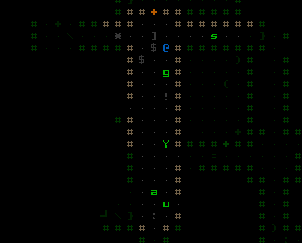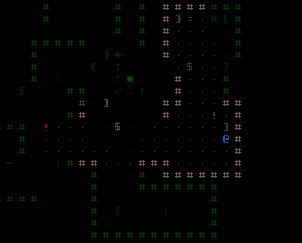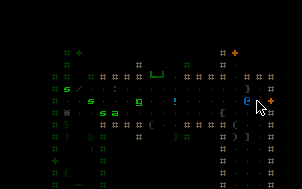First, a recap. Weapons in the 7DRL prototype were divided into four categories:
- Guns: Encompass a wide variety of beam and projectile weapons.
- Cannons: More powerful than guns, but with heavy resource costs.
- Launchers: Fire explosives including rockets, bombs, etc.
- Special: A small category of tools that could potentially be used as weapons, like mining lasers and welding torches.
While categories can also be subdivided by their damage type, there is plenty of room for additional tweaks to further expand on weapon variety and increase the tactical options.
Guided Weapons
One feature left sitting in the 7DRL engine code because there wasn’t enough time to balance it in is guided weapons. Enabling it was a simple matter of adding it to the UI, so now you can set waypoints for a guided weapon and shoot around robots or obstacles to hit a specific target.
Combined with a spotter or scanning system that can penetrate walls, guided weapons will be quite an asset. Because they never miss and can be incredibly useful, guided weapons will be fairly rare, and costly to use. (Another reason it made sense to leave them out of the 7DRL prototype--they’re fun but not an essential common feature.)
Guided weapons override normal volley rules of firing all active weapons at once: Regardless of other weapon states, if a guided weapon is active it will be the only one to fire since it uses a non-direct targeting system. If multiple guided weapons are active, only the first will fire (you can change their order, or deactivate all but one, to control which will fire in this case). If an active guided weapon will be overriding the next volley, a label appears next to it in the parts list:
Salvos
The 7DRL prototype always followed the “one weapon, one projectile” rule, which just isn’t good enough for some weapons. For example, a “Rocket Array” is far more impressive if it actually launches a barrage of rockets every time you fire it. So the game now supports weapons that fire multiple projectiles.
Overload
Some energy weapons can now be set to “overload.” In this state the weapon does double damage for double the energy cost while producing triple the base heat.
Each such weapon also has a stability rating that determines how likely it is to malfunction if fired while overloaded. The chance is generally not high, but if it does happen the weapon could drain your energy reserves, cause a massive surge of heat, short circuit other parts, or even meltdown. Nonetheless, even with the drawbacks it’s another viable tactical option for increasing your damage potential when otherwise low on firepower, or to do a significant amount of damage in a short time to avoid being overwhelmed.
The overload state is cycled on via the normal activation procedure (clicking on the weapon, or pressing its corresponding letter), so there are no extra commands to remember, and you will quickly learn which weapons can be overloaded without even looking at their stats.
Next we’ll start looking at some of the overall UI improvements underway.




